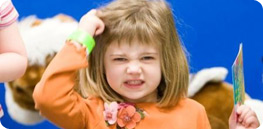QUESTION: I am having a hard time knowing what nits look like. And, how would I know if nits are alive, dead or hatched?
ANSWER: Nits are laid on the hair and glued to one side of the hair shaft. They are usually laid on single strands of hair, close to the scalp, but not on it. Nits are not round, but oval. They are light-colored when first laid (yellowish or gray), but darken to a tan or coffee color as the embryo develops. Once the egg hatches, the spent shell remains attached to the hair shaft. As the hair grows, the nit grows with it and is farther from the scalp.
QUESTION: Several kids in the neighborhood have been infested with head lice. I sometimes transport my daughter and neighborhood kids to school, soccer practice and other events. Should I be treating the car seats for head lice to keep her from getting lice?
ANSWER: It is not likely that lice will end up on car seats and upholstery, but it is possible. Surface sprays are not recommended because most of the insecticidal sprays marketed for treating lice can cause allergic reactions for people who have allergies or respiratory problems. Instead, we recommend vacuuming the backs of the seats after transporting kids.
QUESTION: Isn’t there anything that will help remove nits from the hair? So many products claim to do this, but I am having a hard time finding a product that works.
ANSWER: The protein in the nit glue is chemically close to the protein in hair itself. Any solvents that would dissolve the glue are likely to damage the hair. Manually removing the nits with a high quality lice comb is your best option. We recommend The LiceMeister© and Terminator removal comb.
QUESTION: Should you keep your child at home in case of an active infestation at school, or in case your child is actively infested?
ANSWER: Children should never stay home from school because they themselves or their classmates have head lice! This contributes to stigmatization of children with head lice, which is entirely undesirable and uncalled for! Head lice are a completely natural phenomenon and have nothing to do with a lack of hygiene or other personal or family conditions!
QUESTION: Who is most likely to get head lice?
ANSWER: Head lice have been found on people of all socio-economic levels. Children, particularly those of elementary school age, are most likely to get head lice because of their close contact and social interactions with each other (e.g., sharing hats, combs and brushes)
QUESTION: Do vinegar rinses help remove lice eggs?
ANSWER: No, vinegar will not dissolve the cement-like substance that the female louse uses to attach her eggs to the hair shaft. A high quality nit comb is the only real reliable method for removing the eggs. Although trimming the hair is not necessary, it does make it easier to remove all of the nits.
QUESTION: Do I need to spray my home with an insecticide if someone in my family has lice?
ANSWER: No, lice cannot survive for more than 24 to 48 hours when removed from a person. They do not live in cracks or crevices like cockroaches or other household pests. Spraying furniture, carpets and bedding with an insecticide serves no real purpose other than providing some margin of psychological comfort. Although such sprays kill an occasional stray louse, family members who are already being treated would be exposed unnecessarily to insecticides. If anything, vacuuming carpets and furniture will remove stray lice.
QUESTION: Do head lice spread diseases?
ANSWER: No, head lice are not known to transmit any disease agents. However, secondary infections may result if the skin is broken by repeated scratching.
QUESTION: Are lice and nits resistant against malathion and/ or permethrine, the active insecticides in most lice treatments?
ANSWER: Yes! Increasingly resistance is being reported against these insecticides, the active ingredients in most prevailing lice treatments are failing. No single traditional insecticide-based lice treatment now guarantees a successful treatment without manual removal of all nits as well.
QUESTION: What can we do to prevent head lice?
ANSWER: The sooner nits (eggs) and lice are detected, the easier it is to remove them because they multiply quickly. The Lice Clinic recommends that parents of young children screen regularly; make it part of your regular hygiene routine.
More questions? Email our Head Lice Specialist at liceadvice@liceclinic.ca

